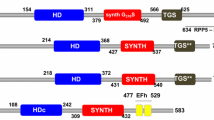Abstract
Higher plants have a number of PsbP homologs (PsbP-like proteins: PPLs, PsbP-domain proteins: PPDs) in addition to the authentic PsbP in the oxygen-evolving complex of photosystem II (PSII). Among the PsbP homologs, the PPL1 protein is most homologous to a cyanobacterial PsbP (cyanoP), and we previously reported that PPL1 is required for the efficient repair of photo-damaged PSII under high light conditions [Ishihara et al. (2007) Plant Physiol. 145: 668-679]. However, functional role of PPL1 in the PSII repair cycle has not been clarified yet. In this study, we further investigated molecular function of PPL1 by characterizing the phenotypes of the PPL1 knockdown plants (ppl1i) in which PPL1 expressions were differently suppressed. Although growth of the ppl1i mutants under low intensity light was comparable with that of wild type plants, PSII activity of the ppl1i mutants was more sensitive to high intensity light and the extent of photoinhibition was correlated with the levels of the knocked-down PPL1. The possible functional role of PPL1 in PSII repair is discussed.
Access this chapter
Tax calculation will be finalised at checkout
Purchases are for personal use only
Similar content being viewed by others
References
Enami I, Okumura A, Nagao R, Suzuki T, Iwai M, Shen JR (2008) Structures and Functions of the Extrinsic Proteins of Photosystem II from Different Species. Photosynth Res. 98(1–3): 349–363
Ifuku K, Ishihara S, Shimamoto R, Ido K, Sato F (2008) Structure, Function, and Evolution of the PsbP Protein Family in Higher Plants. Photosynth Res 98: 427–437
Ifuku K, Ishihara S, Sato F (2010) Molecular Functions of Oxygen-Evolving Complex Family Proteins in Photosynthetic Electron Flow. J Integr Plant Biol. 52(8): 723–34
Ishihara S, Takabayashi A, Ido K, Endo T, Ifuku K, Sato F (2007) Distinct Functions for the Two PsbP-Like Proteins PPL1 and PPL2 in the Chloroplast Thylakoid Lumen of Arabidopsis. Plant Physiol 145: 668–679
Mulo P, Sirpiö S, Aro EM (2008) Auxiliary Proteins Involved in the Assembly and Sustenance of Photosystem II. Photosynth Res. 98: 489–501
Roose JL, Wegener KM, Pakrasi HB (2007) The Extrinsic Proteins of Photosystem II. Photosynth Res. 92(3): 369–387
Seidler A (1996) The Extrinsic Polypeptides of Photosystem II. Biochim. Biophys. Acta 1277: 35–60
Author information
Authors and Affiliations
Corresponding author
Rights and permissions
Copyright information
© 2013 Zhejiang University Press, Hangzhou and Springer-Verlag Berlin Heidelberg
About this paper
Cite this paper
Matsui, S., Ishihara, S., Ido, K., Ifuku, K., Sato, F. (2013). Functional Analysis of PsbP-Like Protein 1 (PPL1) in Arabidopsis. In: Photosynthesis Research for Food, Fuel and the Future. Advanced Topics in Science and Technology in China. Springer, Berlin, Heidelberg. https://doi.org/10.1007/978-3-642-32034-7_86
Download citation
DOI: https://doi.org/10.1007/978-3-642-32034-7_86
Publisher Name: Springer, Berlin, Heidelberg
Print ISBN: 978-3-642-32033-0
Online ISBN: 978-3-642-32034-7
eBook Packages: Biomedical and Life SciencesBiomedical and Life Sciences (R0)



